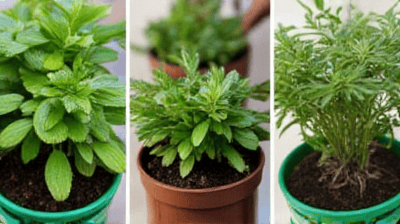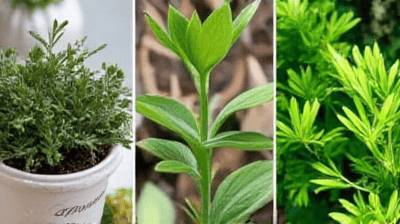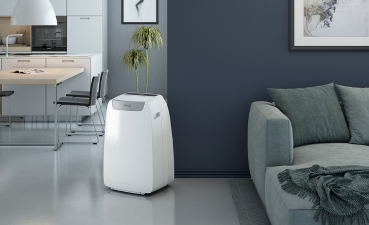Home gardening has become an immensely popular hobby over the past few years, especially for those looking to incorporate fresh ingredients into their meals. One of the best ways to ensure a continuous supply of fresh herbs throughout the year is to grow them indoors. Not only do these herbs enhance the flavor of your dishes, but they also elevate the aesthetic of your living space with their lush green foliage. In this comprehensive guide, we will explore seven herbs that are perfect for indoor gardening and can thrive all year round with the right care and conditions.

1. Basil
Basil is a beloved culinary herb known for its sweet and aromatic flavor. It is a key ingredient in many Italian dishes, such as pesto, pasta, and caprese salad, and it also works wonderfully in a variety of other cuisines.
Growing Requirements
- Light: Basil thrives in bright, direct sunlight. Ideally, place your pots near a south-facing window where they can receive at least six hours of sunlight a day.
- Soil: Use well-draining potting soil that is rich in organic matter. Basil prefers a slightly acidic to neutral pH (around 6 to 7).
- Temperature: This herb prefers warm temperatures, ideally between 70 and 90 degrees Fahrenheit. Avoid placing it in drafts or near chilly windows.
Care Tips
- Watering: Keep the soil consistently moist but not soggy. Water when the top inch of soil feels dry. Basil loves humidity, so misting the leaves occasionally can help.
- Fertilizing: Use a balanced, water-soluble fertilizer every four to six weeks during the growing season to promote healthy growth.
Culinary Uses
Fresh basil is used in sauces, salads, and as a garnish. It pairs beautifully with tomatoes, garlic, and cheese. You can also use it to make pesto by blending basil leaves with olive oil, nuts, and cheese.
Harvesting
You can begin harvesting basil once the plant is about six inches tall. Regularly trim the leaves to encourage bushier growth. Always harvest from the top so that new branches can develop.
2. Chives
Chives are another versatile herb with a mild onion flavor. They can enhance many dishes, and their slender green shoots add a beautiful touch to any indoor garden.
Growing Requirements
- Light: Chives prefer bright, indirect light for about six hours a day. If you notice them getting leggy, they may need more light.
- Soil: Chives thrive in well-drained potting mix. They do well in slightly acidic to neutral pH levels.
- Temperature: They grow best in temperatures between 60 and 75 degrees Fahrenheit.
Care Tips
- Watering: Ensure the soil remains slightly moist but not waterlogged. Overwatering can lead to root rot, so let the top inch of soil dry out between waterings.
- Fertilizing: Use a balanced fertilizer every few weeks during the growing season to encourage robust growth.
Culinary Uses
Chives are perfect for adding a mild onion flavor to dishes. Use them fresh in salads, soups, and as a garnish for baked potatoes or egg dishes. They also work well in dips and sauces.
Harvesting
Snip the leaves of your chives at the base whenever needed. Regular harvesting promotes new growth and a more vibrant appearance.
3. Mint
Mint is a fragrant herb that brings a refreshing flavor to a variety of dishes and beverages. It is perfect for making tea, adding to desserts, and garnishing cocktails.
Growing Requirements
- Light: Mint thrives in bright, indirect sunlight but can tolerate some direct sun. Ideally, it should receive about four to six hours of light each day.
- Soil: Use a nutrient-rich, well-draining potting mix. Mint prefers slightly acidic to neutral pH levels.
- Temperature: Mint enjoys moderate temperatures, ideally between 65 and 75 degrees Fahrenheit.
Care Tips
- Watering: Keep the soil consistently moist—mint enjoys a humid environment. Water regularly, especially during warmer months.
- Potting: It’s best to grow mint in a separate pot, as it can quickly take over other plants due to its vigorous growth habit.
Culinary Uses
Mint is widely used in beverages like iced tea, mojitos, and mint juleps. It complements fruits, salads, and savory dishes, particularly lamb. You can also use it to make mint sauce or add it to yogurt for a refreshing dip.
Harvesting
Pick mint leaves as needed. The more you harvest, the bushier the plant will become. Be sure to remove flowers as they appear, as flowering can diminish the quality of the leaves.

4. Rosemary
Rosemary is a robust herb with a distinct flavor that pairs well with meats, vegetables, and breads. It is known for its aromatic leaves and is a staple in Mediterranean cooking.
Growing Requirements
- Light: Rosemary needs full sunlight for at least six to eight hours a day, making it ideal for a sunny windowsill.
- Soil: Use a well-draining, sandy potting mix, as rosemary does not like waterlogged roots.
- Temperature: Keep rosemary in a warm environment, ideally between 65 and 75 degrees Fahrenheit. Protect it from extreme cold.
Care Tips
- Watering: Allow the soil to dry out between watering; rosemary prefers drier conditions. Water less frequently in cooler months.
- Fertilizing: Feed rosemary with a diluted liquid fertilizer every four to six weeks during the growing season.
Culinary Uses
Rosemary is perfect for flavoring roasted meats, potatoes, and baked breads. Its strong flavor makes it ideal for hearty dishes, but a little goes a long way. You can also use it to infuse oils or vinegars.
Harvesting
Cut sprigs of rosemary as needed, removing the top third of the plant to promote bushier growth. Avoid cutting into the woody stems, as this can hinder new growth.
5. Thyme
Thyme is a hardy herb known for its strong flavor, which is commonly used in Mediterranean cuisine. It is drought-resistant and easy to maintain, making it perfect for indoor gardening.
Growing Requirements
- Light: Thyme requires at least six hours of sunlight daily. A south-facing window is ideal for optimal growth.
- Soil: Use well-draining potting soil, as thyme does not tolerate waterlogged conditions.
- Temperature: Thyme thrives in temperatures between 60 and 75 degrees Fahrenheit.
Care Tips
- Watering: Allow the soil to dry out completely between waterings. Thyme is drought-tolerant, so don’t be too quick to water.
- Fertilizing: Use a diluted liquid fertilizer every four to six weeks during the growing season to support growth.
Culinary Uses
Thyme is a staple in stews, soups, roasted meats, and vegetables. It complements a variety of savory dishes and is often used in marinades and dressings.
Harvesting
You can start harvesting thyme once the plant is established. Trim the leaves as needed, taking care not to remove more than one-third of the plant at a time, as this can stress it.
6. Oregano
Oregano is a key herb in many kitchens, especially for pizza and pasta dishes. It is a hardy, low-maintenance herb that thrives indoors with proper light and care.
Growing Requirements
- Light: Oregano requires at least six hours of sunlight daily, so place it in a sunny spot.
- Soil: Use a well-draining potting mix to prevent waterlogging. Oregano thrives in slightly alkaline to neutral pH levels.
- Temperature: It thrives in temperatures between 60 and 75 degrees Fahrenheit.
Care Tips
- Watering: Water when the top inch of soil is dry, as oregano prefers drier conditions. Overwatering can lead to issues like root rot.
- Fertilizing: Use a balanced fertilizer every four to six weeks during the growing season for optimal growth.
Culinary Uses
Oregano is essential for Italian and Greek cuisine. It is perfect for seasoning sauces, marinades, and meat dishes. Dried oregano is commonly used, but fresh leaves offer a more vibrant flavor.
Harvesting
Harvest oregano by cutting the stems just above a leaf node, which encourages bushier growth. You can also dry or freeze excess oregano for later use.
7. Parsley
Parsley is a versatile herb known for its bright green leaves and fresh flavor. It’s widely used in culinary dishes and serves as a decorative garnish.
Growing Requirements
- Light: Parsley needs bright, indirect sunlight for about four to six hours a day. It can tolerate partial shade as well.
- Soil: Use a well-draining potting mix that is rich in organic matter. Parsley prefers slightly acidic to neutral pH levels.
- Temperature: Ideal temperatures for growing parsley are between 65 and 75 degrees Fahrenheit.
Care Tips
- Watering: Keep the soil moist but avoid overwatering. Parsley prefers consistent moisture, so check frequently.
- Fertilizing: Apply a balanced fertilizer every four to six weeks during the growing season to support healthy growth.
Culinary Uses
Parsley is commonly used in salads, soups, and sauces. It can be added fresh or used as a dried herb. Parsley enhances the flavor of many dishes and adds color as a garnish.
Harvesting
Harvest the outer leaves first, allowing the center to continue growing. Regular trimming encourages new growth and keeps the plant healthy.
Conclusion
Growing herbs indoors is a rewarding experience that can provide you with fresh flavors for your cooking and stunning greenery for your home. The satisfaction of harvesting herbs that you have nurtured is unparalleled. By selecting the right herbs and providing them with proper light, water, and care, you can enjoy a flourishing indoor garden year-round. Start with these seven herbs, and soon you will have fresh ingredients ready at your fingertips, making your culinary creations all the more delightful.
Creating an indoor herb garden not only enhances your cooking but also promotes relaxation and well-being. The simple act of nurturing plants can bring joy and satisfaction, making it a perfect hobby for anyone interested in home gardening. So, gather your pots, seeds, and gardening tools, and get ready to cultivate your indoor garden of herbs.



